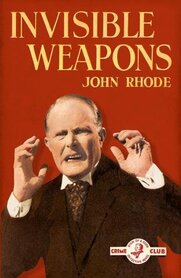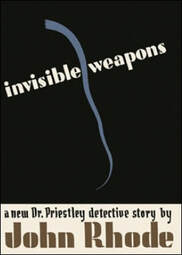
Are the two deaths related? Dr. Priestley seems to think so. If so, how was Robert Fransham struck down when he was alone in a room? And where is the weapon? Consensus from bloggers and readers place Invisible Weapons as a solid but unremarkable entry from author Cecil John Charles Street’s more than 140 detective stories published under the names John Rhode and Miles Burton. I would agree with that assessment: it is a breezy, fast read, aided by the two-for-one structure and a good representative title to show the author’s interest in plot and investigatory procedure with minimal interest in character development or complicated motives. It is also one of the few John Rhode titles currently in print, thanks to the recent publication of this book and three others by HarperCollins, who have resurrected the Collins Crime Club imprint.
As workaday as this genre story is, Street provides a few spots of enjoyable character development, such as the presence of Alfie Prince, a mentally deficient tramp who goes door to door asking for cigarettes and gets angry when denied his pleasure. I also appreciated the spirited speech of a neighbor named Willingdon, which shows that the author can infuse characterization through dialogue when he chooses to. (Much more often, Jimmy Waghorn will ask a question or two of a person and receive straightforward paragraphs in reply that read like a dispassionate witness statement.)
As reviewers have noted, it is the remarkable obtuseness of the police – and their complete failure to connect the dots without Dr. Priestley’s help – that strains credulity the most here. Hanslet in particular is fixated on Dr. Thornborough for Fransham’s murder, an unshakeable belief built principally on the fact that the suspect is the only one with an apparent motive: Fransham was about to change his will, and the doctor had recently fallen upon financial hardship. To his credit, Waghorn stops short of arresting Thornborough because he feels evidence is lacking. No one involved questions why a man would invite a near-estranged relative to his own home and then murder him under mysterious circumstances when an accident away from the estate would have generated far less suspicion and achieved a better effect.
Some proposed secondary theories are also head-scratching and unconvincing, yet Superintendent Hanslet accepts them as possible, no grain of salt needed. One example: because tramp Alfie (or at least his singular coat) was seen in the neighborhood of Adderminster shortly before the murder, one speculative idea is that Dr. Thornborough managed to get Alfie to kill for him. The doctor, knowing that Alfie’s mental stability sometimes caused blackouts and memory loss, would be safe as he could trust his assassin to promptly forget his role. Hanslet is astute enough to consider variations and scenarios like that one, but logic and common sense are given only to amateur criminologist Priestley.

This is also one of those tales where quite a bit of luck and coincidence needs to go the murderer’s way, from the trajectory of the weapon to a rented truck sitting in a garage on the premises and conveniently overlooked for days after the crime. Perhaps that all comes with the territory of mystery fiction; it’s a pleasant enough garden path up which to walk. Just don’t look too closely at the reality of the details, either of the criminal’s fragile plan or of the policeman’s remarkable ignorance.
In part because of the modern reprinting, many reviews of Invisible Weapons can be found online. Among the learned bloggers spilling some virtual ink: TomCat at Beneath the Stains of Crime; Puzzle Doctor at In Search of the Classic Mystery Novel; Nick at The Grandest Game in the World; Martin Edwards at his Crime Writing Blog; and JJ and Aidan offer a detailed, spoiler-stuffed discussion at The Invisible Event.
 RSS Feed
RSS Feed